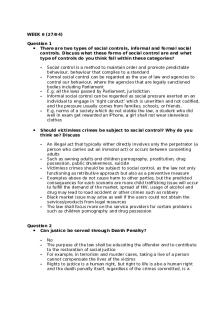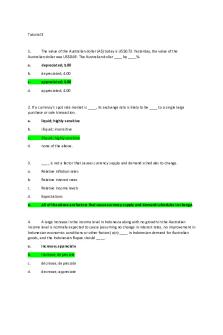3 Tutorial Force Sept19 PDF

| Title | 3 Tutorial Force Sept19 |
|---|---|
| Author | Anonymous User |
| Course | Fluid Mechanics |
| Institution | Universiti Teknologi MARA |
| Pages | 6 |
| File Size | 350.9 KB |
| File Type | |
| Total Downloads | 8 |
| Total Views | 157 |
Summary
question and answer tutorial fluid mechanics...
Description
TUTORIAL 2.1: Hydrostatic – Force
EC110/UiTMKS2
1. The top of each gate shown in Figure Q1 lies 4 m below the water surface. Find the location and magnitude of the force acting on one side assuming a vertical orientation. 3m 2m
3m
4m
4m
(a)
(b) Figure Q1
(c)
2. A trapezoidal drainage of 2-m wide at the bottom and 1.5-m deep has side slopes of 45⁰. A vertical trapezoidal gate of the same dimensions is placed in the drainage. If the gate is closed (water level is the same as the depth of drainage), determine the total force acting on the gate and the location of the center of pressure. 3. A circular plate of 4 m diameter with a circular hole of 1 m diameter is shown in Figure Q3. The plate is immersed in water at an angle of 30⁰ to the horizontal and with its top edge 2 m below the free surface. Determine the resultant force on plate and its location.
Figure Q3 4. A rectangular plane surface, 1 m wide and 1.6 m deep lies in water so that its plane makes and angle of 350 with the water surface. a) By referring to Figure Q4, explain the relation between the resultant force and the centre of pressure. b) Calculate the total pressure and position of the centre of pressure when the upper edge is 0.85 m below the water surface.
Figure Q4
bcbsept19
1
TUTORIAL 2.1: Hydrostatic – Force
EC110/UiTMKS2
5. A 3-m long curved gate is located in the side of a reservoir containing water as shown in Figure Q5. Determine the magnitude of the resultant force and its direction.
Figure Q5 6. A radial gate of radius 4 m and length 6 m is shown in Figure Q6. Based on the diagram, what is the resultant hydrostatic thrust acting on the gate? Determine also the direction and location of the force.
Figure Q6 7. The water side of the wall of a 100-m-long dam is a quarter circle with a radius of 10 m. Determine the hydrostatic force on the dam and its line of action when the dam is filled to the rim. 8. A 5-m-high, 5-m-wide rectangular plate blocks the end of a 4-m-deep freshwater channel, as shown in Figure Q8. The plate is hinged about a horizontal axis along its upper edge through a point A and is restrained from opening by a fixed ridge at point B. Determine the force exerted on the plate by the ridge.
Figure Q8 9. The 200-kg, 5-m-wide rectangular gate shown in Figure Q9 is hinged at B and leans against the floor at A making an angle of 45° with the horizontal. The gate is to be opened from its lower edge by applying a normal force at its centre. Determine the minimum force F required to open the water gate. bcbsept19
2
TUTORIAL 2.1: Hydrostatic – Force
EC110/UiTMKS2
Figure Q9 10. A sluice gate (Figure Q10) consists of a quadrant of a circle of radius 1.5 m pivoted at its centre O. Its centre of gravity is at G as shown. When the water is level with the pivot O, calculate the magnitude and direction of the resultant force on the gate due to the water and the turning moment required to open the gate. The width of the gate is 3 m and it has a mass of 6000 kg.
Figure Q10 11. Gate is commonly designed to control water levels and flow rates in river, canal and estuary. Figure Q11 shows an L-shape gate with 1-m width which opens automatically by rotating about hinge A when the seawater level rises. Apply the concept of hydrostatic thrusts on the plane surface to solve the water depth, Z above hinge A which is required to open the gate. Given the specific gravity of seawater is 1.20.
Figure Q11 12. Determine the magnitude and direction of the horizontal and vertical components of the hydrostatic force acting on curved surface AB as shown in Figure Q12, which has a radius of 2 m and a width of 4 m.
bcbsept19
3
TUTORIAL 2.1: Hydrostatic – Force
EC110/UiTMKS2
8m Water A R
B
Figure Q12 13. Referring to Figure Q12. Assume that the water exists on the opposite side of the vertical barrier. The surface AB have extended to semicircular with point A still located 8 m below the surface level. Determine the magnitude and direction of the horizontal and vertical components of the hydrostatic force acting on the semicircular curved surface. 14. Figure Q14 shows a solid cylinder sitting on the bottom of a tank holding a static volume of water. Compute the force exerted by the cylinder on the bottom of the tank for the following data: 𝐷 = 152 𝑚𝑚, 𝐿 = 0.25 𝑚, 𝛾𝐶 (𝑠𝑡𝑒𝑒𝑙) = 77.12 𝑘𝑁 ⁄ 3 , 𝛾𝑓 = 9.81 𝑘𝑁⁄ 3 (𝑤𝑎𝑡𝑒𝑟), 𝑚 𝑚 ℎ = 0.76𝑚
𝛾𝑓
h
𝛾𝐶 D
Figure Q14 15. A rectangular gate AB with dimensions of 3 m wide and 2 m high is hinged at A. The gate is used to separate seawater and freshwater as shown in Figure Q15. By applying pressure diagram, determine the external force, Fe, acting at the bottom of the gate that is required to keep the gate close. Assume the density of seawater as 1025 kg/m3.
bcbsept19
4
TUTORIAL 2.1: Hydrostatic – Force
EC110/UiTMKS2
Figure Q15 16. A bulkhead 3 m long divides a storage tank as shown in Figure Q16. On one side, there is a petrol of specific gravity of 0.78 stored to a depth of 1.8 m, while on the other side is an oil of specific gravity 0.88 stored to a depth of 0.9 m. Determine the resultant force on the bulkhead and the position at which it acts measured from the bottom. Use pressure diagram.
1.8 m
Petrol Oil
0.9 m
Figure Q16
bcbsept19
5
TUTORIAL 2.1: Hydrostatic – Force
EC110/UiTMKS2
Answers 739.657 kN, 6.167 m 1
313.9 kN, 5.5 m 333.501 kN, 5.722 m
2
33.109 kN, 0.917 m
3
350.555 kN, 3.11 m
4
20.544 kN, 1.363 m
5
440.601 kN, 48.1⁰
6
456.484 kN, 39.3⁰
7
77.048 MN, 57.5⁰
8
287.786 kN
9
1907.099 kN
10
61.652 kN, 57.5⁰, 35.281 kNm
11
2.655 m
12
706.32 kN (to the right) 661.508 kN (downwards)
13
- 1,323.048 kN, downwards
14
305.35 N
15
44.976 kN
16
26.699 kN, 0.718 m
bcbsept19
6...
Similar Free PDFs

3 Tutorial Force Sept19
- 6 Pages

CIMA assignment brief - Sept19
- 14 Pages

Tutorial 3
- 3 Pages

Tutorial 3
- 4 Pages

Lab 3 force summer 2011
- 4 Pages

3 Net Force Practice Problems
- 7 Pages

Tutorial 3
- 4 Pages

Tutorial 3
- 12 Pages

3 - tutorial
- 6 Pages

Tutorial 3
- 6 Pages

Tutorial 3
- 4 Pages

Report Phy-3-Force and Motion
- 15 Pages

Tutorial 3 - Lecture notes 3
- 5 Pages
Popular Institutions
- Tinajero National High School - Annex
- Politeknik Caltex Riau
- Yokohama City University
- SGT University
- University of Al-Qadisiyah
- Divine Word College of Vigan
- Techniek College Rotterdam
- Universidade de Santiago
- Universiti Teknologi MARA Cawangan Johor Kampus Pasir Gudang
- Poltekkes Kemenkes Yogyakarta
- Baguio City National High School
- Colegio san marcos
- preparatoria uno
- Centro de Bachillerato Tecnológico Industrial y de Servicios No. 107
- Dalian Maritime University
- Quang Trung Secondary School
- Colegio Tecnológico en Informática
- Corporación Regional de Educación Superior
- Grupo CEDVA
- Dar Al Uloom University
- Centro de Estudios Preuniversitarios de la Universidad Nacional de Ingeniería
- 上智大学
- Aakash International School, Nuna Majara
- San Felipe Neri Catholic School
- Kang Chiao International School - New Taipei City
- Misamis Occidental National High School
- Institución Educativa Escuela Normal Juan Ladrilleros
- Kolehiyo ng Pantukan
- Batanes State College
- Instituto Continental
- Sekolah Menengah Kejuruan Kesehatan Kaltara (Tarakan)
- Colegio de La Inmaculada Concepcion - Cebu


